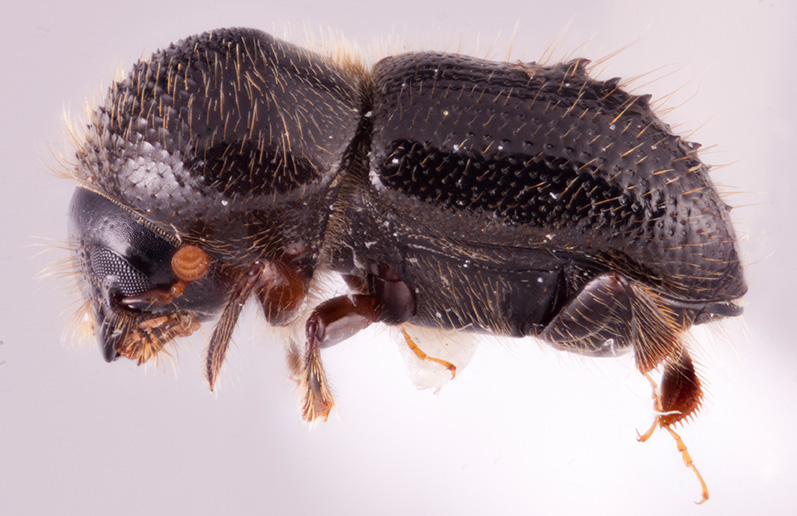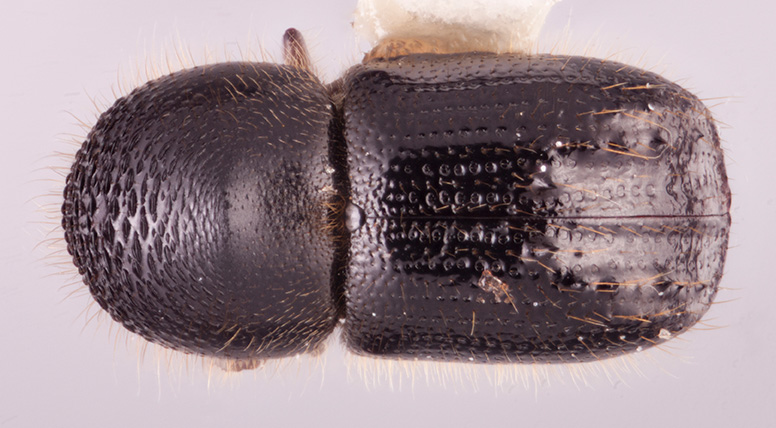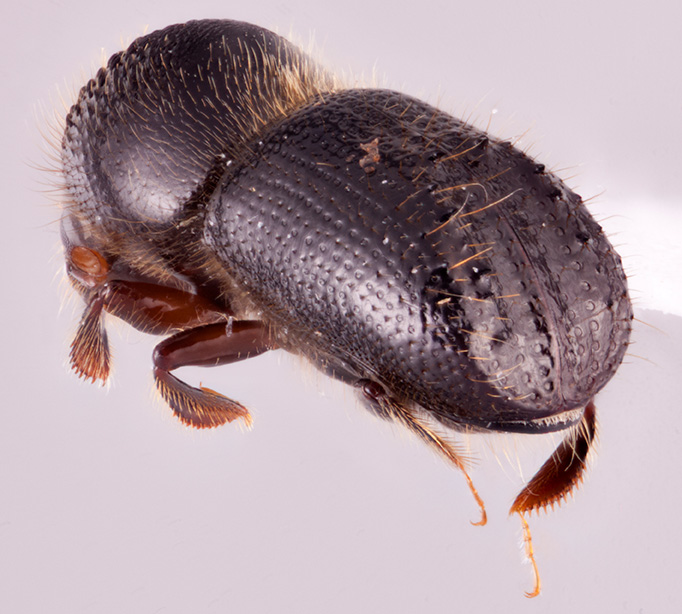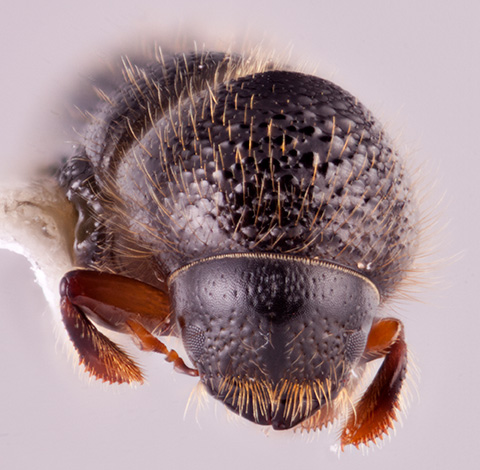Anisandrus cristatus
|
Anisandrus cristatus lateral; R.K. Osborn |
|
Anisandrus cristatus dorsal; R.K. Osborn |
|
Anisandrus cristatus declivity; R.K. Osborn |
|
Anisandrus cristatus frontal; R.K. Osborn |
Taxonomic history
Xyleborus cristatus Hagedorn, 1908: 377.
Xyleborus fabricii Schedl, 1964c: 217. Unnecessary replacement name.
Synonyms
Xyleborus cristatus Hagedorn, 1908: 377.
Xyleborus fabricii Schedl, 1964c: 217. Unnecessary replacement name.
Diagnosis
3.35–3.7 mm long (mean = 3.55 mm; n = 5); 2.2–2.47 times as long as wide. This species can be distinguished by the mesonotal mycangial tuftmycangial tuft:
tuft of setae that denotes the mycangia exterior opening
 the length of the scutellumscutellum:
the length of the scutellumscutellum:
a shield-like sclerotized plate located at the midpoint of the elytral base
; elytralelytral:
pertaining to the elytra
discdisc:
the flat central upper surface of any body part (e.g. pronotum and elytra) with or without a weak transverse saddle-like depression; posterolateralposterolateral:
with or without a weak transverse saddle-like depression; posterolateralposterolateral:
relating to end of the side part/portion
 margin costate to interstriaeinterstria:
margin costate to interstriaeinterstria:
longitudinal spaces along the elytra between the striae, which is not as<br />
impressed and bear smaller punctures.
 5; declivitydeclivity:
5; declivitydeclivity:
downward slope of either the pronotum or elytra
 appearing bisulcatebisulcate:
appearing bisulcatebisulcate:
pertaining to an elytral declivity with two suci; a sulcus present on each elytron but the suture remains convex
, moderately impressedimpressed:
a depression in a surface
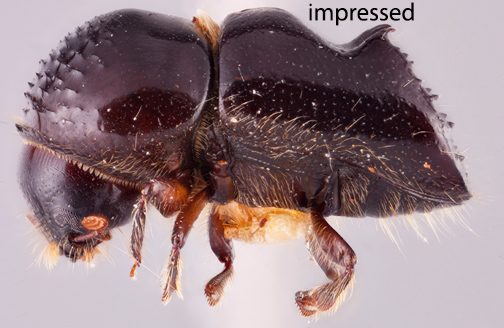 from striaestria:
from striaestria:
punctures in rows, which may or may not be impressed to make grooves 1−2, interstriaeinterstria:
1−2, interstriaeinterstria:
longitudinal spaces along the elytra between the striae, which is not as<br />
impressed and bear smaller punctures.
 3 moderately inflatedinflated:
3 moderately inflatedinflated:
blown up; distended
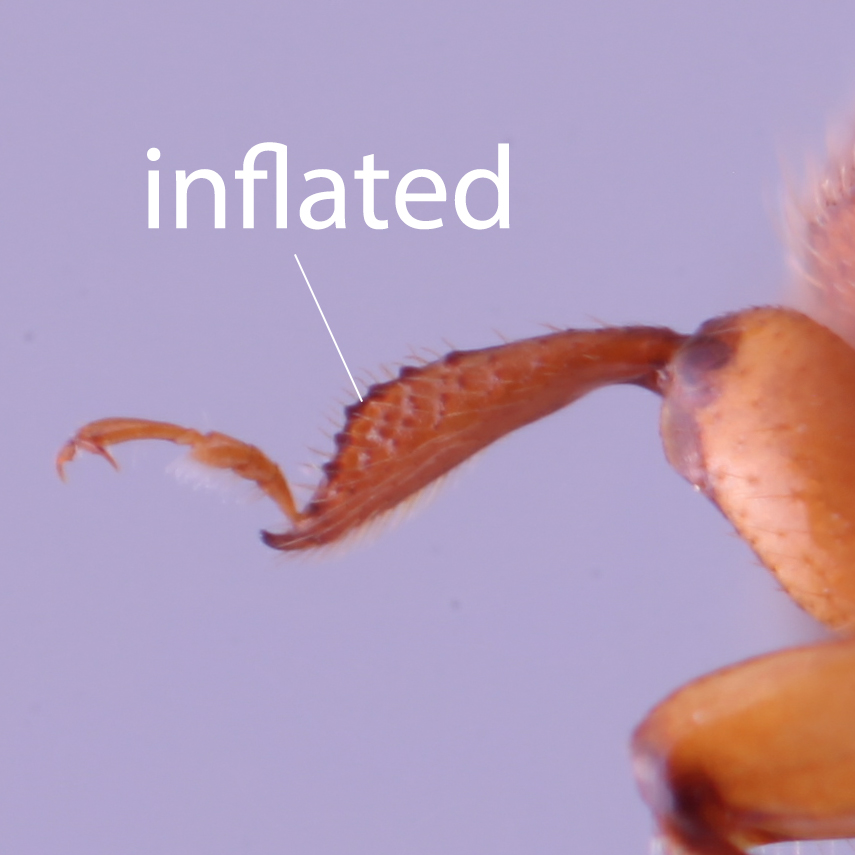 , tuberculate from basebase:
, tuberculate from basebase:
point or edge closest to the body; opposite of apex to apicalapex:
to apicalapex:
point or edge furthest from the body; opposite of base
 quarter then becoming flattened and unarmed to apexapex:
quarter then becoming flattened and unarmed to apexapex:
point or edge furthest from the body; opposite of base
 ; and large sized sharp incurved spinespine:
; and large sized sharp incurved spinespine:
an elongate projection of the exoskeleton that is longer than its basal width on interstriaeinterstria:
on interstriaeinterstria:
longitudinal spaces along the elytra between the striae, which is not as<br />
impressed and bear smaller punctures.
 2 at basebase:
2 at basebase:
point or edge closest to the body; opposite of apex of declivitydeclivity:
of declivitydeclivity:
downward slope of either the pronotum or elytra
 on interstriaeinterstria:
on interstriaeinterstria:
longitudinal spaces along the elytra between the striae, which is not as<br />
impressed and bear smaller punctures.
 2.
2.
This species strongly resembles Anisandrus apicalis and A. n. sp. 8 and is most easily distinguished by the larger size, more strongly impressedimpressed:
a depression in a surface
 declivitaldeclivital:
declivitaldeclivital:
pertaining to the elytral declivity
sulci than A. apicalis and larger spinesspine:
an elongate projection of the exoskeleton that is longer than its basal width on interstriaeinterstria:
on interstriaeinterstria:
longitudinal spaces along the elytra between the striae, which is not as<br />
impressed and bear smaller punctures.
 3 that are sharply pointed and backwardly hooked and subequal in size to the spinespine:
3 that are sharply pointed and backwardly hooked and subequal in size to the spinespine:
an elongate projection of the exoskeleton that is longer than its basal width at the summitsummit:
at the summitsummit:
highest point, used for pronotum and elytra, denotes the peak between pronotal frontal slope and disc, and between elytral disc and declivity of interstriaeinterstria:
of interstriaeinterstria:
longitudinal spaces along the elytra between the striae, which is not as<br />
impressed and bear smaller punctures.
 2.
2.
May be confused with
Anisandrus apicalis, A. congruens, A. geminatus, A. niger, and A. sinivali
Distribution
Bhutan, China (Yunnan), India (Meghalaya, ‘Naga Hills’, Sikkim, West Bengal), Laos, Myanmar, Nepal, Thailand, Vietnam
Host plants
recorded from Alnus (Betulaceae), Quercus (Fagaceae), Symplocos (Symplocaceae) (Beeson 1930Beeson 1930:
Beeson CFC. 1930. The biology of the genus Xyleborus , with more new species. Indian Forest Records 14: 209-272.)
DNA data
Sequences available for COI and CAD.

